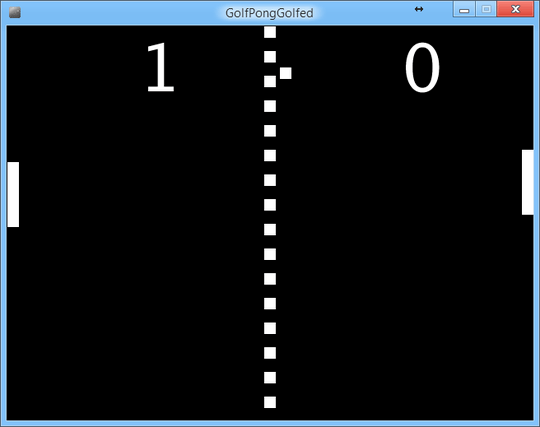HTML & JavaScript - 1663
Against my better judgment, I took the crazy approach of golfing the actual code from the demo. I removed some features and interface elements, but generally it works exactly the same - 0, 1 or 2 to choose the number of human players, Q/A and P/L to move.
Unless I made some mistakes, gameplay should be identical, pixel for pixel and millisecond for millisecond, to the original at 640*480 (hint: resizing the browser window changes the game size in the demo). It just doesn't give instructions, doesn't announce the winner and doesn't handle esc.
The code is fully self-contained and I tested it in Chromium 25 on Linux. Firefox doesn't like it very much.
<body bgcolor=0><canvas id=c height=480><script>R=Math.random
C=c.getContext('2d');f=C.fillRect.bind(C)
S=[l=G=I=J=K=L=0,0];r=17;u=463;o=24;q=12;z=10;s=640;v=36
function T(z,t,u,v){P=0;if(e=v*E-u*F){a=(u*t-v*z)/e;b=(E*t-F*z)/e
a<0|a>1|b<0|b>1?0:P={x:M+a*E,y:N+a*F,d:u,s:0,X:X,Y:Y}}}function
i(p,q,h){T(p-22*(E<0),q,0,h)
P?0:T(p,q-h*(F<0),22,0)}function
U(p){if(p.a)if(M<p.x&X<0|M>p.x+q&X>0)p.u=0
else{P=p.P;if(P&&P.X*X>0&P.Y*Y>0&P.s<p.l/z)P.s+=t
else{E=X*z;F=Y*z;i(M-p.x+5,s*q,s*o)
if(p.P=P){y=P.y;while(y<r|y>u)y=y<r?34-y:y>u?u+u-y:y
P.y=y+R(e=(p.l+2)*(X<0?M-p.x-q:p.x-M)/64)*2*e-e}}P?p.u=P.y<p.y+25?1:P.y>p.y+35?-1:0:0}y=p.y-p.u*t*198
p.y=y<q?q:y>408?408:y}function
W(n,x){a=9.6;b=[~8,3,62,31,75,93,~2,7,-1,u][n]
b&4&&f(x,o,v,a);b&64&&f(x,o,a,o)
b&2&&f(x+v,o,-a,o);b&8&&f(x,43.2,v,a)
b&32&&f(x,48,a,o);b&1&&f(x+v,48,-a,o)
b&16&&f(x,72,v,-a)}A={u:0,x:0,y:210};B={u:0,x:628,y:210}
function g(n){if(++S[n]>8)G=A.a=B.a=0
else{N=R(M=n?635:5)*446+r;Y=157.5;X=n?-Y:Y
A.l=z+S[0]-S[1];B.l=20-A.l}}D=document
D.onkeydown=D.onkeyup=function(e){d=!!e.type[5]
k=e.keyCode-45;if(k>2&k<6&d&!G){G=S=[-1,0];A.a=k<4;B.a=k<5
g(0)}k^31?k^35?k^20?k^v?0:I=d:J=d:K=d:L=d
A.a?0:A.u=I-J;B.a?0:B.u=K-L}
setInterval(function(){t=new Date()/1000-l;l+=t;U(A);U(B)
if(G){E=t*X+4*t*t;F=t*Y+4*t*t
x=M+E;y=N+F;m=X+t*(X>0?8:-8);n=Y+t*(Y>0?8:-8)
if(n>0&y>u){y=u;n=-n}if(n<0&y<r){y=r;n=-n}p=m<0?A:B
i(M-p.x+5,N-p.y+5,70)
if(P){if(P.d){y=P.y;n=-n}else{x=P.x;m=-m}n*=n*p.u<0?.5:p.u?1.5:1}M=x;N=y
X=m;Y=n;M>645?g(0):M<-5&&g(1)}c.width=s;C.fillStyle='#fff'
f(0,0,s,q);f(0,468,s,q);for(j=o;j--;)f(314,6+o*j,q,q)
W(S[0],266.5);W(S[1],338.5)
f(0,A.y,q,60);f(s,B.y,-q,60);G&&f(M-5,N-5,z,z)},50/3)</script>
Some credits to Shmiddty for improvements
 Note: the font used for the score may vary from system to system.
Note: the font used for the score may vary from system to system.

AFAIK, "a free language (in both senses)" is certainly not "always" a requirement. We get plenty of answers in C#, Mathematica, etc. – wchargin – 2014-12-15T00:32:33.843
Honestly, this question is a little too difficult for code golf. The ball physics for Pong is pretty complicated. – beary605 – 2013-03-08T02:18:59.790
@beary605, I don't think the ball physics are too complicated. My solution is 'as close as possible' to the javascript demonstration, and the physics are quite simple. – boothby – 2013-03-08T21:21:18.580
Just for reference there are some other [code-golf]s that run to pretty long. Build an engine for a maze game, Noughts and Crosses (aka Tic-Tac-Toe) (both could use additional entries, who likes to "win" by default?), Write a small HTTP server, Self-Interpreting Interpreter, Self-compiling compiler, Compile Regexes ...
– dmckee --- ex-moderator kitten – 2013-03-08T23:28:44.367@felipa, Can you formalize 'as close as possible'? I don't know why my sed solution isn't in the lead. – boothby – 2013-03-12T19:28:38.517
@boothby My mistake. I didn't have time to actually run the python code and made a wrong assumption. – felipa – 2013-03-13T08:00:32.697
@felipa When you have the time, I would recommend you try it. In its current form, it is as fully featured as the 953 byte HTML/JS solution, with the exception that there is no pause function. Graphically, I think it is also quite agreeable. Nevertheless, I would like to request that it not be selected as the accepted answer, as its validity seems to be contentious. – primo – 2013-03-13T08:30:17.493
1
@beary605 too difficult?
– FantaC – 2017-11-28T20:30:57.193Why so ugly colors? – sergiol – 2018-03-29T23:54:16.450